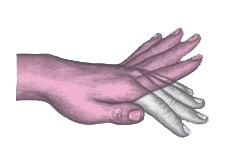This page is under development
The condition of non-infantile, neuronopathic Gaucher’s Disease is characterized by the features of PME.
GD is a lysosomal storage disorder resulting from deficient activity of glucocerebrosidase and the accumulation of its substrate, glucocerebroside, made up of a long chain amino alcohol (sphingosine), a long chain fatty acid and a molecule of glucose 210. The storage material occurs primarily in cells of the macrophage-monocyte system, resulting in a multisystem disease with progressive visceromegaly and gradual replacement of the marrow with distinctive lipid-laden macrophages, the Gaucher cells211.
There are three subtypes, with types 2 and 3 having neurologic involvement. Type 2 disease progresses rapidly, resulting in death in early childhood 210 and is characterised by bulbar palsy, hepatosplenomegaly, spasticity and seizures 212.
Type 3 disease (the juvenile form) has been subclassified into types 3a and 3b. Patients with type 3a disease have progressive neurologic deterioration, often with recurrent myoclonic and generalized tonic-clonic seizures and moderate hepatosplenomegaly211. Neurological signs include horizontal supranuclear gaze palsy, dementia, spasticity and ataxia 210. Type 3b is characterized by significant hepatosplenomegaly and supranuclear gaze palsies, the latter being the sole neurological sign 210. A family in which two siblings with slowly progressive, late onset myoclonus, intention tremor and gaze palsies has been described212. PME as a result of Gaucher’s disease has been described in an adult, commencing at the age of 17213.
1.6.14.1 Diagnosis
Diagnosis is confirmed by markedly reduced ß-glucosidase activity towards the substrate, glucosylceramide.
1.6.14.2 Myoclonus
Myoclonus is described as being progressive, refractory to medication and stimulus sensitive212. Typically, jerks begin in the limbs and become progressively more stimulus sensitive, reacting to noise or touch. Negative myoclonus may also be observed. Both myoclonic and generalized seizures may occur.
1.6.14.3 Clinical Manifestations
Progressive neurological deterioration, with frequent myoclonic seizures and hepatosplenomegaly.
1.6.14.4 Special Investigations
EEG may show spike and wave discharges, either multifocal or diffuse 213 214;215SEPs may be significantly increased in amplitude in patients with type 3 Gaucher disease 216.
In type 3 GD there is neuronal loss in cortical and subcortical structures 210, and Gaucher cells may be present in brain parenchyma 215.
1.6.14.6 Neuropathology
Verghese reported on a case with onset of Gaucher disease in the second year of life, with stimulus sensitive myoclonus and normal EEG. Cerebral cortex was normal, as were the basal ganglia and brainstem, excepting for Alzheimer type 2 astrocytes in the SN, and the inferior olivary nucleus. There was marked loss of neurons in the cerebellar dentate nucleus with many of the residual neurons showing pyknosis and nuclear condensation. The fiber loss was selective to the dentatorubrothalamic pathway with loss of fibers in the superior cerebellar peduncle but not in the cerebellar white matter or the other peduncles211. Conradi reported on a young child with severe myoclonus and spike and wave activity on EEG215. The cerebral cortex and white matter showed focal alterations consisting of intra-parenchymal and perivascular accumulation of Gaucher’s cells. The dorsal tegmentum, pons and medulla showed Gaucher’s cells and astrocytosis and astrogliosis around capillaries to varying degrees215. There was a slight loss of Purkinje cells and the granular cell layer was affected by a focal, severe loss of granule and Golgi cells, as well as astrogliosis and intra-parenchymal Gaucher’s cells215. The dentate nucleus showed a severe loss of neurons with astrocytosis and astrogliosis.
Winkelman described two siblings with Gaucher disease, one of whom had myoclonus which worsened prior to a seizure212. Cerebral cortex and brainstem were normal, although collections of Gaucher cells were widely disseminated in the basal ganglia and subcortical white matter212. . Relatively diffuse involvement of the brainstem was present, with neuronophagia and nests of microglia. The inferior olive showed diffuse astrogliosis, and there was severe disease of the dentate, fastigial, and emboliform nuclei, with preservation of the Purkinje cell and granule cell layer212.
1.6.14.7 Genetics
Mutations in the glucocerebrosidase gene include point mutations, insertions and substitutions210.
210. Brady RO, Barton NW, Grabowski GA. The role of neurogenetics in Gaucher disease. Arch Neurol 1993;50:1212-24.
211. Verghese J, Goldberg RF, Desnick RJ, Grace ME, Goldman JE, Lee SC, Dickson DW, Rapin I. Myoclonus from selective dentate nucleus degeneration in type 3 Gaucher disease. Arch.Neurol. 2000;57:389-95.
212. Winkelman MD, Banker BQ, Victor M, Moser HW. Non-infantile neuronopathic Gaucher's disease: a clinicopathologic study. Neurology 1983;33:994-1008.
213. King JO. Progressive myoclonic epilepsy due to Gaucher's disease in an adult. J Neurol Neurosurg Psychiatry 1975;38:849-54.
214. Kaye EM, Ullman MD, Wilson ER, Barranger JA. Type 2 and type 3 Gaucher disease: a morphological and biochemical study. Ann Neurol 1986;20:223-30.
215. Conradi N, Kyllerman M, Mansson JE, Percy AK, Svennerholm L. Late-infantile Gaucher disease in a child with myoclonus and bulbar signs: neuropathological and neurochemical findings. Acta Neuropathol.(Berl) 1991;82:152-7.
216. Garvey MA, Toro C, Goldstein S, Altarescu G, Wiggs EA, Hallett M, Schiffmann R. Somatosensory evoked potentials as a marker of disease burden in type 3 Gaucher disease. Neurology 2001;56:391-4.

